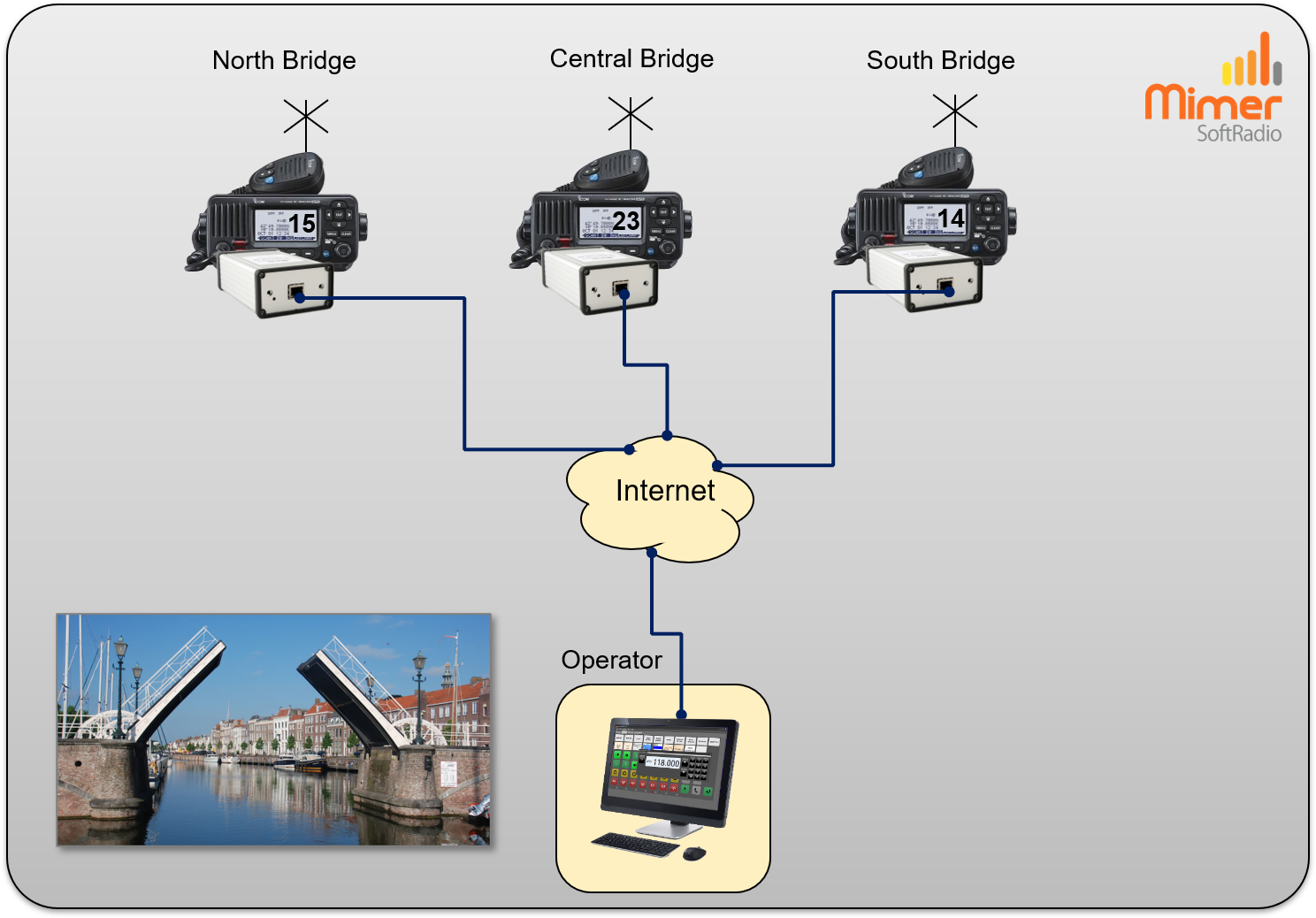Mimer SoftRadio - Harbour,
Coast and River Systems
Operators handling ships that are along a coast line or along a river needs to use several base station sites. SoftRadio helps the operator to follow the ship as it passes along the different sites.
Please also see the other pages with marine examples.

User Video
One of our dealers have made a video about the remote control of radios located at folding bridges on the inland water ways of the Netherlands.
They use SoftRadio for remote control of fixed marine VHF radios at each bridge, as you can see on the video.
Watch it on Youtube.
Radios along the coast
A coastal radio dispatcher often needs to use several radio sites in order to get coverage along a coastal line. In the example to the right there are four radios at different sites. This can of course be many more.
The dispatchers can listen to all radios at the same time and transmit on either one of them. Dispatchers does not need to be at the same site, they can be spread out and back up each other.
If the option GroupSend is added to the system, the operator can also transmit on several radios at the same time.
Some Marine VHF channels are meant for duplex use, and SoftRadio can work in full duplex. So if you also choose a base radio that works in duplex the operator will be able to talk to the ship while listening on the same radio channel.
The whole coast line of Thailand have a SoftRadio system with 55 fixed radios.
Inland Water Ways
Same thing applies to an Inland Water Way. You will need several radio sites to cover the stretch of the river.
Typically you will be get reception from several of the radio sites when a ship calls. Connecting the base radios through a receiver voting system helps the dispatcher to get the best reception at all times. Further described here.
On European Inland Water Ways you also need the function ATIS messaging that identifies the ship when transmitting. Further described on the MarineCalls page.
The rivers of Sava and Oder have systems with SoftRadio.
Harbour System
This harbour has three local radios operated from two operators. One of the radios have selectable channels and two have fixed channels, so that the operators always will have those two channels in focus. In addition they also have two radios that work in the Public Safety Tetra network (Rakel).
There is also a harbour about 100km north and another harbour 80km south of the main site. These two harbours have one radio each with selectable channels.
For redundancy purposes there is an extra operator position located at another site, to be used if the ordinary operator site needs to be vacated due to fire or other crisis.
The example above comes from the Stockholm Harbour.
Bridge System
Bridges needs to be opened and locks needs to be operated. The ship then needs to talk to the river control centre.
Often there are several bridges along the waterway. If the bridges are close to each other, one radio might cover the whole water way. But if they are further apart it is better to place one radio local at each bridge. Often there is a good IP connection at the bridge that can be used for the remote control.
If the same channel is used at all bridges, the use of receiver Voting is recommended. This will give the operator a better audio from the ships.
Both in Sweden and in the Netherlands we have systems to talk to ships that needs a bridge to be opened.
How many radios per site?
To build a safe and secure system you will often need to have more than one base station radio at each radio site.
In some cases it is best to have two multi channel radios that work in exactly the same way. If one should go down, you can use the other one. Either have the extra radio as a standby radio, or use them both in parallel on different channels.
But in some cases a better combination is to have one multichannel base station that can work with any radio channel and then also have one base radio that has a fixed channel for the most commonly used channel. Maybe CH16 or another call channel for a harbour or waterway. With the same fixed channel on several sites a setup with voting is recomended.
In SoftRadio systems we often setup a third radio that is only used for DSC calls. This radio is fixed to CH70 and can´t be used for voice calls.
Helpful SoftRadio Options
- Receiver Voting
With voting (diversity) several base station sites can receive the same signal from the ship, but only the strongest signal is presented to the operator.
Read more here. - DSC and ATIS
For identification of the ship that is transmitting, DSC and ATIS are helpful.
Read more here. - CrossPatch
With the CrossPatch option radio channels and also phone calls can be patched together.
Read more here. - Phone connection
The operator can handle phone calls from the same software as the radio calls.
Read more here.






